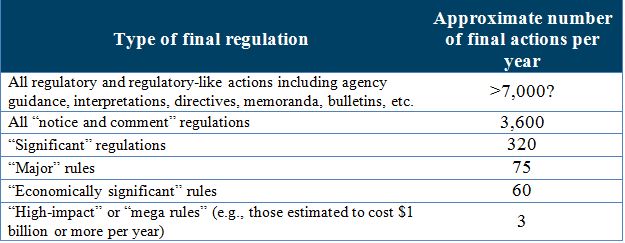On Monday, President Trump signed an executive order on “Reducing Regulation and Controlling Regulatory Costs.” He pledged in his 100-day plan to reduce regulatory burdens on businesses, both small and large, and in his usual fashion, the president declared as he signed the order that it would be the “biggest such act that our country has ever seen.” However, the devil is in the details, and the executive order (EO) doesn’t specify how this policy will be implemented, which could have a “huge” impact on its effectiveness.
The EO seems to impose two constraints. First, it requires that agencies eliminate two regulations for every new one issued (what the administration is calling a “one-in-two-out”). Second, it sets a cap on incremental regulatory costs. In fiscal year 2017, the EO sets the cap at zero, but in future years, it directs the director of the Office of Management and Budget to establish an incremental cost allowance for each agency. The order also calls on the OMB director to develop guidance to agencies for implementing these requirements.
Experience in other countries
A policy of offsetting the costs of new regulations by revising or eliminating existing ones has the potential to not only reduce the accumulation of regulatory burdens, but to force evaluation of what has and hasn’t worked in the past. Other countries, including the United Kingdom and Canada, have successfully implemented regulatory offset programs (one-in-three-out in the U.K. and one-for-one in Canada). These programs are based on regulatory costs (compliance costs in the U.K. and administrative burdens in Canada).
One-in-two-out
The one-in-two-out requirement is rule-based, so which regulations will be counted as “ins” and “outs” will be important. The EO relies on a more sweeping definition of “regulation” than previous orders have, and includes an “agency statement of general or particular applicability…,” which could possibly encompass guidance documents or even compliance letters. OMB’s guidance will be key here and will have a significant effect on both the success of two-for-one and the time and manpower required to implement it.
For example, as our working paper “Implementing a Two-for-One Regulatory Requirement in the U.S.” explains, targeting all rules would apply to thousands of actions per year; such a threshold would require significant manpower to evaluate rules with relatively little effect on the public (such as rules governing operating times for drawbridges and fireworks displays). Limiting the application to “significant” regulations, as defined by EO 12866, would cover about 300 rules per year, and would target those rules anticipated to have more substantial effects. Or focusing even more narrowly, the two-for-one policy could target “mega” rules, or those with annual impacts of over $1 billion, which would only extend to a few rules per year.

Incremental cost cap
Although the two-for-one component of the EO fulfills the president’s campaign pledge, the binding constraint will likely be the incremental cost cap, and here too, OMB guidance will be important. As discussed in our working paper, how costs are defined will affect agencies’ workload as well as the program’s ultimate impact. The most straightforward measure of cost would be administrative burden, the metric Canada’s one-for-one system uses, and similar to measures U.S. agencies already develop pursuant to the Paperwork Reduction Act.
A focus on business compliance costs, as the U.K. does in its one-in-three-out policy, would be more comprehensive and meaningful to the small business community that supports the EO but would also be more time consuming to estimate. The most meaningful regulatory cost measure would be total social cost or the “opportunity cost” of regulations. Although presidents since 1981 have required agencies to estimate the social costs of major new regulations before they are issued, such analysis is nontrivial, especially for existing regulations.
Potential to improve regulatory evaluation
While new regulations are often analyzed to estimate whether their benefits will outweigh their costs, the scope and reach of regulation has grown dramatically over the last several decades. Like pebbles tossed in a stream, each individual regulation may do little economic harm, but eventually the pebbles accumulate and like a dam, they may block economic growth and innovation.
A policy of removing two regulations for every new one would provide agencies incentives to evaluate the costs and effectiveness of those accumulated regulations and determine which ones have outlived their usefulness. Although many presidents have encouraged agencies to retrospectively review their regulations, President Trump’s EO may provide agencies with some of the strongest incentives for assessing the costs—and the benefits—of their existing rules. To comply, agencies should take a critical eye to their own rules to identify those that return the smallest benefits at the highest cost.
See also:
Working paper: Implementing a Two-for-One Regulatory Requirement in the U.S., by Marcus Peacock
Forbes: President-elect Trump’s Two-for-One Plan to Reduce Regulatory Accumulation, by Susan E. Dudley
Commentary: Ten Regulatory Process Reforms President-elect Trump Could Undertake, by the GW Regulatory Studies Center
Forbes: Ten Regulatory Process Reform Recommendations For President-Elect Trump, by Susan E. Dudley
Executive Order: Reducing Regulation and Controlling Regulatory Costs

